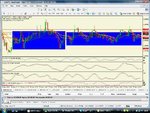For most novice traders, trading range breakouts will be a losing strategy: false breakouts will result in losses, corrections will fake traders out of legitimate moves, and explosive gains are rare considering the many potential ranges available to trade.
Hi 15 min tlb,
You may well be right, but not because there's anything inherently wrong in trading a range breakout strategy.
Essentially, there really are only
three basic trading styles or strategies available to any trader. It makes little difference whether one is trading a discretionary or mechanical method and, if the former, whether one trades with indicators or a price only 'naked trading' type of methodology. The reason being that if a trader uses a TA based methodology, then pretty much all the recognized ones are derivatives of these three basic approaches: retracements, reversals and breakouts (as explained in the FAQ linked above). With very few exceptions, any strategy that doesn't fit into one of the above will, likely as not, be based on a non-TA approach (e.g. HFT algo' based mechanical strategies). Even then, if one looks at a chart showing the entries and exits of such approaches, chances are that the entry will either be designed to join an established trend (i.e. trend continuation) or be designed to pick tops or bottoms - or breakouts into blue sky territory. These can either be at the extreme ranges of a trend, pullbacks within a longer term trend or tops and bottoms within a trading range or period of consolidation. Basically, those are the only choices available to any trader. It makes little difference what their approach is. It can be TA based or fundamentally based. It can involve the moon and the stars and all manner of hocus pocus or it can be based on Nobel prize winning scientific logic. It matters not.
At the end of the day, all the above have a potential for both profit and loss. As far as I'm aware, there's no evidence to suggest that any one of them is any more or less profitable than another. Ultimately, success or failure, profit or loss, is down to each individual trader. It doesn't mean that any one approach is better or worse than another or that one is more or less likely to result in profit (or loss) than another.
Just my humble opinion - not official T2W policy!
🙂
Tim.






